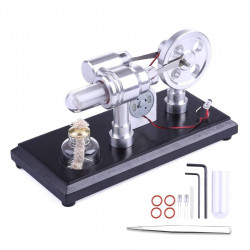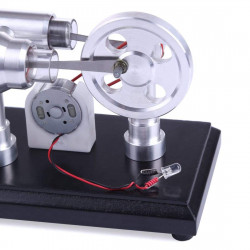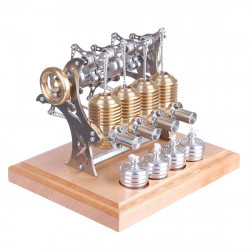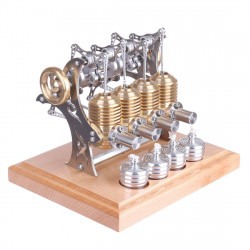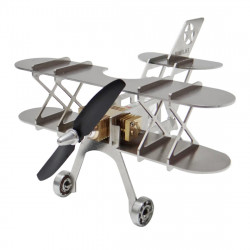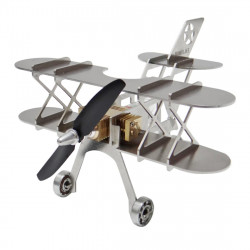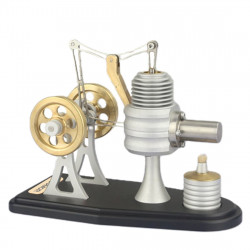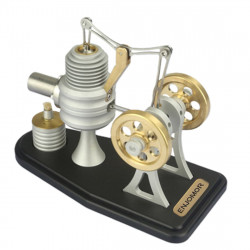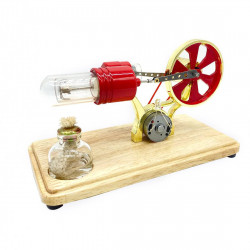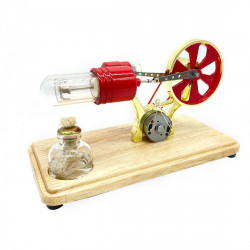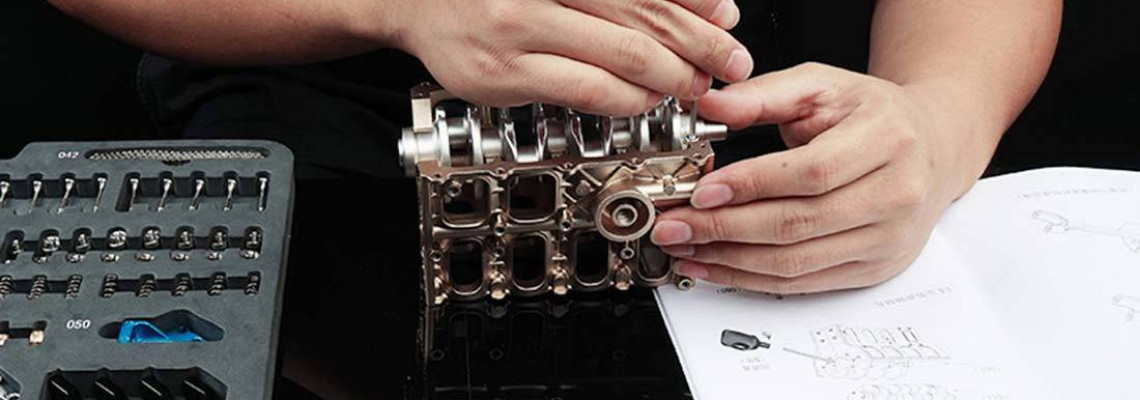
Harley Davidson Motorcycle Engine History
For power machinery enthusiasts, 1903 is unquestionably a memorable year because it was the year the Wright brothers made their first flight and Ford was founded. For American locomotive enthusiasts, however, the most significant year is undoubtedly the birth of Harley-Davidson, which led the freedom-loving riders on a journey that lasted for 120 years. Let's go over Harley-Davidson engine power development history today.
1903 Single Cylinder F-head
In 1903, Harley Davidson was born in Milwaukee, Wisconsin, next to Lake Michigan. The Harley-Davidson empire was built on a single-cylinder motor.
The first Harley-Davidson motorbike was a single-cylinder model with belt drive and atmospheric valve control, and it was on display in the main foyer on Juneau Avenue. Prior to the HD V-twin's introduction to the market in 1909, the business solely manufactured single-cylinder motorcycles.
1909 First V-twin
The first V-Twin (V-type twin-cylinder) engine was created by Harley Davidson in 1909 and was given the designation F-Head. The F-Head, a popular single-cylinder engine at the time, had a displacement of roughly 800cc. However, only 27 of these engines were made overall because of some unfixable flaws, and they were taken off the market in the second year. Even though this engine ultimately failed to establish itself in the market, the "V" form it produced was highly significant and served as the "template" for future Harley engine styling.
1911-1929 F-Head
1911 saw the improvement of the already well-known F-Head by adding the 7D model. Thus, the original F-Head was acknowledged as Harley Davidson's first V-Twin engine once the V-Twin progressively gained popularity.
The drive shape and location of the intake and exhaust valves are the most notable aspects of the F-Head. The F-Head's exhaust valve is mounted on the side of the piston, and the crankshaft's power is also transferred through the tappet. The intake valve is positioned on top of the cylinder and is opened and closed by the crankshaft's power. Additionally, Harley-Davidson's later Side Valve (side valve) was built on this concept, which further motivated the V-Twin engine to switch to an OHV (overhead valve) structure.
1929 Flat Head
Harley Davidson successfully created the "Flathead" V-Twin engine in 1929. It was the first engine mass-produced with a side valve.
The term "side valve" (sometimes referred to as an L-head engine or a side valve engine) refers to an engine where the intake and exhaust are positioned side by side on the side of the cylinder, lower than the combustion chamber. It is referred to as "Flathead" because the cylinder head is flat due to the intake and exhaust being mounted on the side of the cylinder. In actuality, flathead valves were the first to be used in cars. Its benefits include stability, affordability, and simplicity. Many machines, like lawnmowers and agricultural equipment, still require similar features today. One of the engines with the most extended lifespan was the Flathead, which was later refined in numerous iterations and operated until 1972. The vintage Model D was equipped with the first Flathead, which had a displacement of roughly 750cc.
1936-1947 Knucklehead
In 1936, Harley Davidson introduced the first V-Twin engine, Knucklehead, as an OHV, marking a significant shift in engine design.
The Knucklehead's performance has also increased to a new level due to the OHV design's significant improvement in valve efficiency when compared to the prior Flathead. By altering the angle of the "V" shape, a knucklehead can change the exhaust sound and vibration rhythm while maintaining a strong torque at low speeds. These features and technologies are still in use today. Knucklehead's displacement was initially set at 1000cc. However, a subsequent variant with a displacement of 1200cc was created. Since then, Knucklehead has been referred to as Big Twin (in contrast to Flathead's Baby Twin) due to the more significant displacement. Knucklehead is a part of the OHV style. The valve's location is shifted from the Flathead's side design to the top. A finger joint-like appearance is also produced by the addition of the oil lubrication design surrounding the valve, which further complicates the engine's top shape. This is also where the moniker Knucklehead came from.
1948-1965 Panhead
From 1948 to 1965, the renowned Harley-Davidson Panhead engine—fondly referred to as the Panhead by those in the know—was in use for 17 years. However, numerous subsequent automakers are still making copies of the well-known twin until now, fifty years after this engine's manufacture ceased! Since many people consider the Panhead to be the most exquisite Harley-Davidson engine ever produced, it is genuinely iconic!
1966-1983 Shovelhead
Following the Knucklehead and Panhead, the Shovelhead is the third iteration of Harley's OHV V-twin. It is a contemporary, dependable, and powerful engine. As for the equipment, the head is brand-new for this engine; the cylinders are cast iron, have two valves per cylinder, and have a single camshaft with four cams. The cylinder heads are made of aluminum.
1984-1999 Evolution
Evolution, which means rebirth, is the name Harley-Davidson gave this new engine.
The main visual difference between Evolution and Shovelhead is that Evolution's cylinder head, upper, and cylinder block are all composed of aluminum alloy, which significantly reduces weight and improves heat dissipation. In addition to the cast iron and aluminum alloy cylinder mix found inside the engine, the automated production process has also increased the precision of the valve. Furthermore, Harley-Davidson created the aluminum alloy piston and added 12% silicon to it, significantly lowering thermal expansion and frictional loss while in use. Moreover, another engine technology that emerged at this time was the usage of CVs (negative pressure carburetors).
1999-2006 Twin Cam 88
The most recent generation of Harley-Davidson engines is called Twin Cam.
The Twin Cam 88 engine, which took the place of the Evolution engine, was introduced by Harley-Davidson in 1999. The output power was significantly increased and the displacement was increased from the initial 1340cc to 1450cc. The new Dyna and Touring car series came equipped with it. The Twin Cam engine's design of 1450cc displacement and two camshafts not only creates more space on the side of the cylinder block due to the enlarged cylinder bore, but it also offers more displacement and horsepower output because each of the engine's two cylinders has two independent camshafts (also known as the "double camshaft"). The cooling fins surrounding the cylinder have also been increased. The most crucial heat dissipation efficiency of the air-cooled engine has also been significantly improved thanks to the Twin Cam88's 50% larger cooling fin than the Evolution.
2007 Twin Cam 96
Harley-Davidson reintroduced the Twin Cam 96 in 2007 with a 1584cc displacement increase.
2012 Twin Cam 103 V-twin
All Harley-Davidson Touring models have strong passing power because of the Twin Cam 103 powerplant, which is equipped with an oil cooler on Touring variants.
The Twin Cam 103 engine improved performance for all Harley-Davidson Softail models in 2012. For improved ergonomics, the Fat Boy and Fat Boy Lo have new, shorter handlebars. Due to the thinner, lower seat design, the Fat Boy rider assumes a different "bike" position. For easier tire replacement and maintenance, a new optional "tubeless" chrome-plated aluminum profile lace-up wheel option will be offered for the Softail Deluxe and Heritage Softail Classic.
2017 Milwaukee-Eight 107
The Milwaukee-Eight, named after its birthplace and its number of valves—double that of the Twin Cam motor that has been in the lineup since 1999—will be the ninth iteration of Harley-Davidson's iconic Big Twin, which will be introduced in 2017. According to Harley-Davidson, the new engine architecture offers a smoother ride, increased torque, more excellent sound, faster throttle response, and better fuel economy.
Let's finally listen to these engines together and anticipate hearing more in the future.
